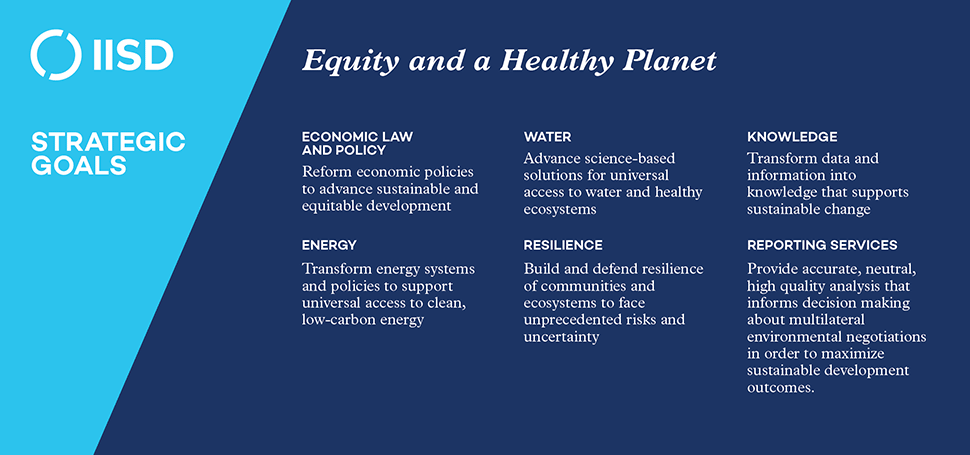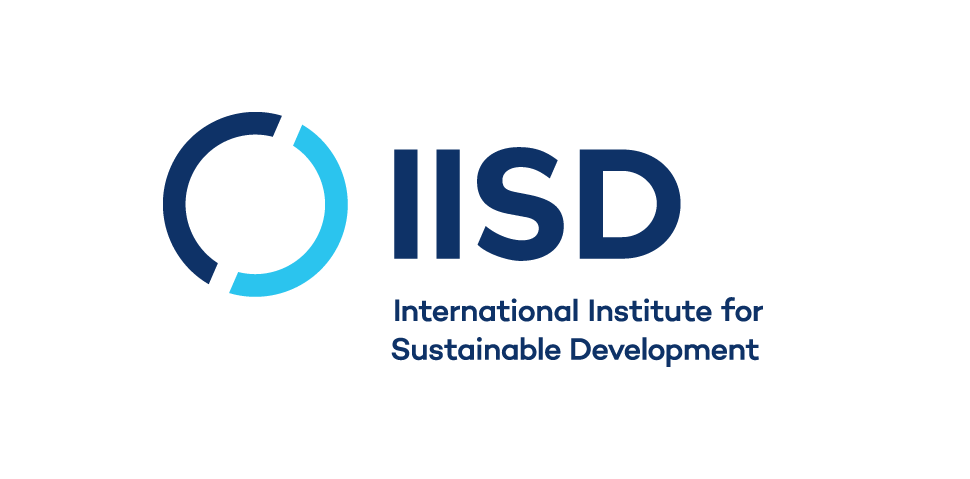IISD Refreshes Its Visual Identity
A new IISD visual identity, released over the past few months, is a recognition of the conviction that how we communicate our work is an integral part of our mission.
In the 25 years since IISD was established our mission to promote human development and environmental sustainability has become more urgent.
History-making strides have been made to lift billions out of poverty, yet the burden that we place on our natural environment is less sustainable than ever.
It was with that broad canvas as a back-drop that IISD renewed its strategic plan last year. The result places a tighter focus on six core priorities that meet the critical need for applied sustainability solutions.
Underpinning our strategy is a belief that communicating both the vital importance of developing sustainably, as well as the work that IISD is doing in support of that objective, is essential to its success. IISD was a global leader in the use of innovative communication when it was founded, including as an early adopter of Web-based communications. But the communication landscape is moving at speed. So must we.
A new IISD visual identity, released over the past few months, is a recognition of the conviction that how we communicate our work is an integral part of our mission. And in the fall we will be launching a new website, which will mark a progression in our use of digital tools to increase our impact.
Designed by Studio Jaywall and Loop: Design for Social Good, the updated visual identity is a departure from our previous look, although it remains rooted in the mission and values that have guided IISD for 25 years. Our new logo is a minimal representation of the globe, split by an opening at 23.5 degrees (the angle of the Earth’s axis tilt). The globe represents IISD’s belief that humanity is confined to the limits of our Earth, while simultaneously representing the global reach of our applied research.
Our new identity is more than just the logo. It’s an entire toolkit of colours, fonts, and graphic elements that work together across all our materials. In particular, it is marked by the occasional use of a ‘shift’ mark, set at the same 23.5-degree angle as the logo. This speaks to the shifts in action that are required for sustainable development—in how we produce, consume, and share our planet’s resources. Below is an example from our recent annual report.
The visual identity as a whole speaks to IISD’s proud history of innovation and experimentation; of testing and championing bold ideas. That has meant tackling the pernicious problem of perverse subsidies—deemed intractable when we first began, but today gaining a strong foothold. It is evident in our focus on greening the financial sector, bridging water science and policy, and using forecasting and measurement tools in support of sustainable development goals.
In short, our new look cuts deeper than a change in fashion. It’s an effort to reflect who we are, how we view the world and the approach we take to our work.
Tell us what you think.
Damon Vis-Dunbar,Director of Communicationsdvis-dunbar@iisd.org
About IISD
The International Institute for Sustainable Development (IISD) is an award-winning independent think tank working to accelerate solutions for a stable climate, sustainable resource management, and fair economies. Our work inspires better decisions and sparks meaningful action to help people and the planet thrive. We shine a light on what can be achieved when governments, businesses, non-profits, and communities come together. IISD’s staff of more than 250 experts come from across the globe and from many disciplines. With offices in Winnipeg, Geneva, Ottawa, and Toronto, our work affects lives in nearly 100 countries.
You might also be interested in
What Drives Investment Policy-makers in Developing Countries to Use Tax Incentives?
The article explores the reasons behind the use of tax incentives in developing countries to attract investment, examining the pressures, challenges, and alternative strategies that exist.
What Is the NAP Assessment at COP 29, and Why Does It Matter?
At the 29th UN Climate Change Conference (COP 29) in Baku, countries will assess their progress in formulating and implementing their National Adaptation Plans. IISD’s adaptation experts Orville Grey and Jeffrey Qi explain what that means, and what’s at stake.
How to Track Adaptation Progress: Key questions for the UAE-Belém work programme at COP 29
UAE-Belem work program at COP 29: Emilie Beauchamp explains the complexity behind these talks and unpacks seven key questions that negotiating countries should address along the way.
COP 29 Must Deliver on Last Year’s Historic Energy Transition Pact
At COP 29 in Baku, countries must build on what was achieved at COP 28 and clarify what tripling renewables and transitioning away from fossil fuels means in practice.


